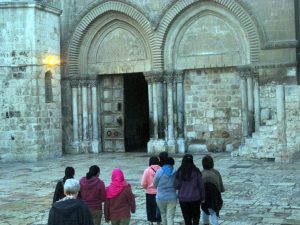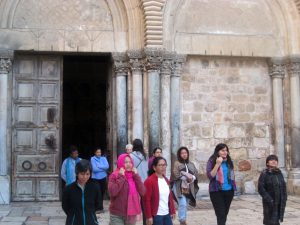Br. Élio, NDS shared with us his knowledge about the Resurrection on Monday Easter. He invited us to think about our tradition of faith from the biblical texts and Jewish interpretation. It is important to keep these dynamics between Synagogue and House of Study, one feeds the other and one should not take the place of the other, they have life only together.
The Jewish religious universe is constituted from the world of the Synagogue which is the space where we manifest our life of faith, life of prayer, religious festivities (Yom Kippur, Shavuot, Passover, etc.) and religious acts (circumcision, Bar and Bat Mitzvah, weddings, etc.). The community of faith or individual observes and leads the liturgical world according to tradition, the habits and practices already received. In the same space, but with another purpose is the House of Study (Beit haMidrash), it is the place and the space of the search of God’s Word, where there are questions and trying to understand better, that is open to all.
This quest is constant, it does not cease when an answer has been found, one must always seek the Word of God.
That is why this practice is a source of renew of the liturgical world, since as new aspects of the Word of God, they are discovered and our life of faith will also be renewed. On the other hand, the liturgy assures the person who prays and who God seeks that his study is not intellectual, but the search for the Word of God is for life and the life of faith. In that sense one aspect depends on the other and one sends the other. One cannot be lived without the other. Not only are the Synagogue and the House of Study physically close, but both they complete each other. Each has its distinct function in the same quest and encounter with God, through his Word within the context of the community.
Br. Élio showed to us the connection between:
Liturgical celebrations – our way to expression our faith;
House of Studs (Beit haMidrash) – Space of the search and study of the Word of God
Sabbath – which we have a week with seven days. The Sabbath is not a day of human activity even God, so to speak, respects it. The story must be completed on the eighth day – day out of time. It’s not in the week, so it’s out of the week. It is the eighth, the eschatological day.
Empty tomb – The tomb must be empty – otherwise one could not speak of the resurrection. God was completely there. It was an empty space; the fullness of God does not follow our measure or our limitation. The Resurrection is about the “spaces” God offers to us to live our mission. The tomb is not empty after all, it is the space of God to spread light and life.
It is the empty tomb that indicates that the world is full of God. Let the risen Jesus empty it of death and fill it with light, love and mission. It is more than a place, it is a way of believing and living in correspondence with all the past of Israel together with the Church that is come to the nations.
From here, a group of people made the experience of God, they transformed that experience into a way of living and they transmitted it and that came to us.
Based on the past we have the responsibility to bear witness to the faith received. The experience made. Transmit what we learn. For us today, how we are transmitting the mystery of Resurrection through our lives? How much have our lives changed with that?
Lúcia de Fátima NDS,
Novice Congregational Novitiate Ein Karem
Jerusalem April 26, 2017


